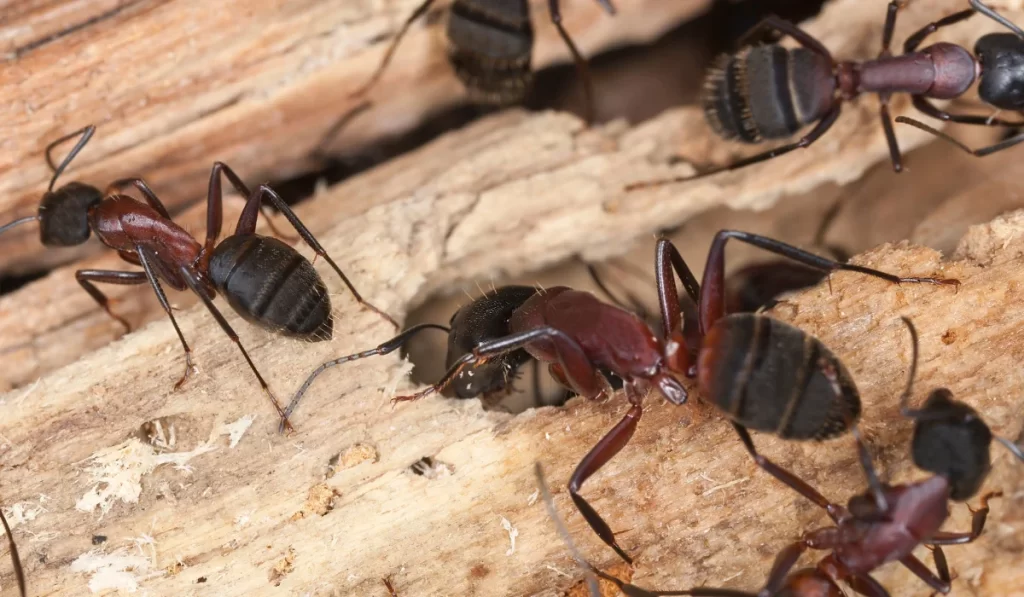If you’re a homeowner in Central Florida, you know the struggle; carpenter ants just love our warm, humid climate. Unlike common kitchen ants, carpenter ants damage wood and can be much harder to spot.
Florida carpenter ants are known for burrowing into wooden structures, leaving behind trails of wood shavings and causing serious structural damage if left unchecked.
Worse still, carpenter ant infestations often go unnoticed until there’s visible damaged wood, hollow-sounding beams, or even the presence of frass (a sawdust-like material made of chewed wood and ant debris).
Let’s break down six targeted ways to get rid of carpenter ants in Orlando homes before they do any more damage.
Key Takeaways
- Damp wood in basements and attics gives carpenter ants the perfect place to start nesting inside your home.
- Tree stumps, overgrown branches, and yard clutter help ants spread from the outside into walls and ceilings.
- Gaps and cracks around doors, pipes, and windows let ants in and should be sealed up with caulk.
- A trained pest control service company in Orlando knows how to find hidden nests and safely remove ants for good.
1. Eliminate Moisture That Attracts Carpenter Ants
Most carpenter ant infestations start in damp wood. In fact, moisture-damaged areas are a top pick for their nesting sites, think leaky pipes, damp basements, or poorly ventilated attics.
Fixing leaks, improving drainage, and running dehumidifiers can make your home a lot less appealing to these wood-boring pests.
They may not eat the wood like termites, but they still do a number on it while tunneling through.
2. Trim Vegetation and Clear Yard Debris
Carpenter ants don’t just wander in randomly.
Many start in outdoor areas like tree stumps, logs, or fallen tree branches, then expand into your home by building satellite nests.
Cut back shrubs and trees touching your roof, remove any decaying wood, and check for ant trails that might be moving from the yard to the house.
This step also helps prevent other pests like fire ants, roaches, and wasps from creeping in.
3. Seal Up Cracks and Entry Points with Caulk
One of the simplest ways to stop ants in their tracks?
Seal up your entry points. Check around windows, doors, vents, and where cables or pipes come through the walls.
Applying high-quality caulk here will keep not just carpenter ants out, but a whole parade of unwanted insects. Make sure to inspect gaps around the foundation, ants are small, but they’re persistent.
4. Eliminate Food Sources and Control Honeydew-Producing Insects
Worker ants are always on the move for something to eat. While carpenter ants tunnel through wood, they still depend on external food sources, especially sweets and proteins.
Left-out pet food, sticky countertops, or even aphids and other pests in your landscaping that produce honeydew can all draw ants to your property.
Regularly clean up spills and manage any bug problems outdoors to reduce what attracts carpenter ants.
5. Use Targeted Ant Control Methods, Not Over-the-Counter Sprays
A lot of DIY methods to get rid of carpenter ants just don’t cut it. In fact, using a general repellent spray might only cause them to scatter and build more nests in hidden voids inside your walls.
Instead, go with non-repellent ant control products and slow-acting baits that can be taken back to the ant colony, eliminating the problem at the source.
Be especially cautious in areas where termites might also be present; misidentifying your ant problem can delay real treatment.
6. Partner With a Local Pest Control Company in Orlando
Sometimes, there’s no substitute for professional help. This species of ants doesn’t always build nests in plain sight. It can burrow deep into wall voids, attics, or even under bathtubs.
So, if you’re seeing large black ants with bent antennae and a rounded thorax, you’re likely dealing with a carpenter ant nest. They are active year-round in Florida and can be much more destructive than folks realize.
Here’s how DIY compares to working with a local pest control expert:
| Feature | DIY Methods | Professional Pest Control |
|---|---|---|
| Effectiveness | Hit-or-miss: Especially with hidden nests | High: Trained pros target the entire colony |
| Risk of Nest Relocation | High: (repellents scatter ants) | Low: Non-repellent methods prevent scattering |
| Time to See Results | Slow: May take weeks or fail entirely | Faster: often within a few days after treatment |
| Product Knowledge | Limited to store-bought solutions | Access to advanced, licensed-only products |
| Long-Term Prevention | Rarely addressed | Often includes inspection and prevention advice |
| Cost | Cheaper upfront | Better value long-term (avoids structural damage) |
At Rowland Pest Management, we specialize in helping homeowners across Orlando and Central Florida take back control with effective, professional ant removal. We’re not just another pest control company; we take time with every inspection, offer next-day service, and treat your home with the same care we would our own.
Your home should feel like yours. Let us help you keep it that way. Give us a call today or schedule your free inspection.
Frequently Asked Questions
If you’re still unsure about what to look out for or how to deal with these pests, here are some common questions homeowners in Orlando often ask about carpenter ants:
Do carpenter ants come out at night or during the day?
Carpenter ants are mostly active at night, especially when it’s quiet and dark. You’re more likely to see them after sundown, foraging for food or moving between nests.
Can carpenter ants live in places other than wood?
Yes, they can nest inside foam insulation, wall voids, and even behind appliances. Wood is their favorite, but they’ll settle wherever it’s quiet, hidden, and close to moisture.
Will cleaning my home help keep carpenter ants away?
Keeping your home clean won’t stop nesting, but it does help. Food crumbs, spills, and open trash can draw in worker ants looking to feed the rest of the colony.


